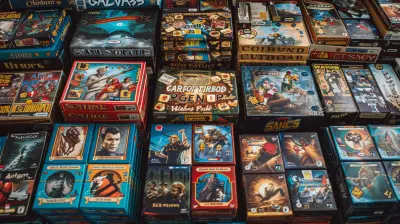The Role of Feedback Loops in Game Advancement
14 September 2025
Have you ever played a game where every choice you made felt meaningful? Where nailing that combo or power-up felt like the game was cheering you on — or messing with you, just a little? That’s the magic of feedback loops at work. They're not just fancy game dev jargon; feedback loops are the reason your little wins feel like epic victories and your mistakes sometimes spiral into oh-no-I’m-losing-fast moments.
Whether you're grinding XP in an RPG, dodging shells in a kart race, or trying to outwit an enemy in a strategy showdown, feedback loops are guiding your experience. Let's dive into what they are, how they work, and why they matter more than you might think.

What Is a Feedback Loop, Anyway?
Alright, let’s start with the basics. A feedback loop in gaming is a system where the game responds to your actions — and then adjusts what happens next based on those actions. Think of it like a conversation between you and the game. You do something, it reacts, and then you respond again. It's the back-and-forth that keeps gameplay dynamic and engaging.There are two main types of feedback loops:
- Positive Feedback Loops – These amplify the player’s success or failure.
- Negative Feedback Loops – These are designed to balance things out and keep the game competitive.
We’ll break these down in a sec, but just know this — feedback loops are everywhere in game design, and they’re a big deal.

Positive Feedback Loops: Winning Bigger, Falling Harder
Let’s talk about the thrill of a victory snowball.A positive feedback loop is like a rolling snowball getting bigger as it picks up more snow. In games, this loop helps players who are already doing well keep winning. Sounds great, right? And it is — sometimes.
Examples of Positive Feedback Loops in Games
- Mario Kart’s Speed Boosts and Item Advantage: If you're in the lead, you're less likely to get hit with powerful items, and you get the best positioning. It feels amazing when you’re crushing it — until a blue shell ends your winning streak.- Leveling Up Faster in RPGs: Higher-level characters often defeat enemies more easily and get better loot. That loot? It makes them even stronger. It's that sweet loop that keeps you grinding until 3AM.
Pros and Cons
🔁 Pros: Positive loops keep the pace fast and the rewards satisfying. They give that sense of "I'm getting better and better!" which is addictive.⚠️ Cons: If left unchecked, they can make a game frustrating for newcomers. No one likes getting steamrolled in the first 5 minutes with zero chance to catch up.

Negative Feedback Loops: Keeping Things Fair and Fun
Now let’s flip the script.A negative feedback loop does the opposite — it helps the underdog. It’s the game’s way of saying, “Hey, don’t worry, you’ve still got a shot.” This keeps things competitive, especially in multiplayer or PvP games.
Examples of Negative Feedback Loops in Games
- Rubber Banding in Racing Games: Ever notice how NPC racers speed up when you’re in the lead? That’s intentional! It keeps the tension high and the races thrilling until the final lap.- Dynamic Difficulty Adjustment (DDA): Some games subtly lower difficulty if you keep dying. It’s not cheating; it’s helping you get back on your feet.
The Good and the Bad
🔄 Pros: Leveling the playing field increases player retention and keeps things exciting. No one wants to quit after feeling hopeless early on.💣 Cons: Too much balancing can feel unfair to skilled players. If you’re clearly better, you want that to matter — not get nerfed by invisible hands.

Where Feedback Loops Shine the Brightest
So, when do feedback loops truly work their magic? In all kinds of games, honestly, but here are a few standout genres where they’re pivotal.Strategy Games
In games like Civilization or StarCraft, every decision ripples through future turns or encounters. A good move gives you momentum (positive loop), while bad choices can slow you down — but give you time to plot a comeback (negative loop).RPGs and Action Games
Ever played Dark Souls? That game punishes mistakes hard. But when you learn from them and finally defeat that boss, whew — pure dopamine. That’s a mix of both loops at once: face-planting into death repeatedly, then riding the high of finally mastering it.Competitive Multiplayer Games
In games like League of Legends or Overwatch, feedback loops help shape player roles. Feed your lane and you start crushing — but the enemy team also gets tools to counter you. It creates a tug-of-war that keeps matches fresh.Game Advancement: How Feedback Loops Drive Progression
Here’s the real reason feedback loops are such a core part of game design: they drive growth. Not just in mechanics, but in your experience as a player.Encouraging Skill Development
Effective feedback loops reward learning. They gently nudge you when you're off-track and high-five you when you're on fire. It’s like having a personal coach built into the game.Creating Emotional Highs and Lows
Games are emotional roller coasters — and feedback loops are the tracks. The wins feel bigger because you remember the losses. That ebb and flow is what keeps games from feeling flat.Shaping the Meta
In online games, loops affect how the meta evolves. A strong strategy creates a positive loop for early adopters. Then counters appear, forming new loops — and the cycle continues. It’s like a living ecosystem.
Feedback Loops vs. Player Autonomy
Here's the million-dollar question: Do feedback loops control us too much?Some players love the structure. Others feel like they're being led by the nose. The best-designed games find the sweet spot — providing enough feedback to steer the experience without taking away your freedom.
Imagine a well-balanced seesaw. That's what the player-game relationship should feel like — a playful push and pull, not one side overwhelming the other.
How Game Developers Tune Feedback Loops
Designing effective loops is more art than science. Game developers playtest obsessively to tweak:- Loop strength: How fast does success snowball?
- Loop timing: When should the loop kick in?
- Player perception: Do players feel in control?
A good dev team listens to the community, watches gameplay data, and constantly adjusts. Ever seen a patch note that nerfs a character or buffs a mechanic? That’s loop tuning in action.
What Happens When Feedback Loops Go Wrong?
Let’s not pretend every loop is perfectly executed. Sometimes, feedback loops backfire.- 🎮 Overpowered Early Game: A weapon or ability that gives too much edge early on creates runaway victories.
- ⛔ Comeback Mechanics Abused: Some players game the system by intentionally losing to trigger easier conditions.
- 💤 Too Balanced = Boring: If the loop always evens things out, progress can feel meaningless.
It’s a fine line between excitement and frustration — and it takes skill to walk it.
The Human Element: Why It Feels Personal
At the end of the day, feedback loops are about communication. The game is talking to you through its systems. When it's done right, it feels like the game gets you — like it’s responding in real time.That’s why you keep playing. That’s why you rage-quit but come back 10 minutes later. There’s a connection, an invisible dance between you and the game world. And feedback loops are the rhythm.
Final Thoughts: Feedback Loops Are the Unsung Heroes
We don’t always notice them, but feedback loops are what make games addictively fun or maddeningly difficult. They're the invisible hands shaping your journey from noob to legend.They drive competition, fuel progression, and keep things spicy. Whether you're chasing that next level or trying to claw your way back after a setback, you'll find feedback loops right there with you — whispering encouragement or dishing out tough love.
So, the next time you feel a game pushing back or speed-boosting your success, take a second to appreciate those clever little systems. They might just be the most important part of the game you're playing.
all images in this post were generated using AI tools
Category:
Game ProgressionAuthor:

Avril McDowney
Discussion
rate this article
1 comments
Jacqueline McSweeney
Great article! I love how you highlighted the importance of feedback loops in gaming. They really enhance the player experience by making us feel more connected to our progress. It's fascinating to see how developers use this to keep us engaged. Looking forward to more insights like this!
September 21, 2025 at 4:41 AM

Avril McDowney
Thank you for your kind words! I'm glad you found the article insightful. Feedback loops truly do play a crucial role in enhancing player engagement. Stay tuned for more!


